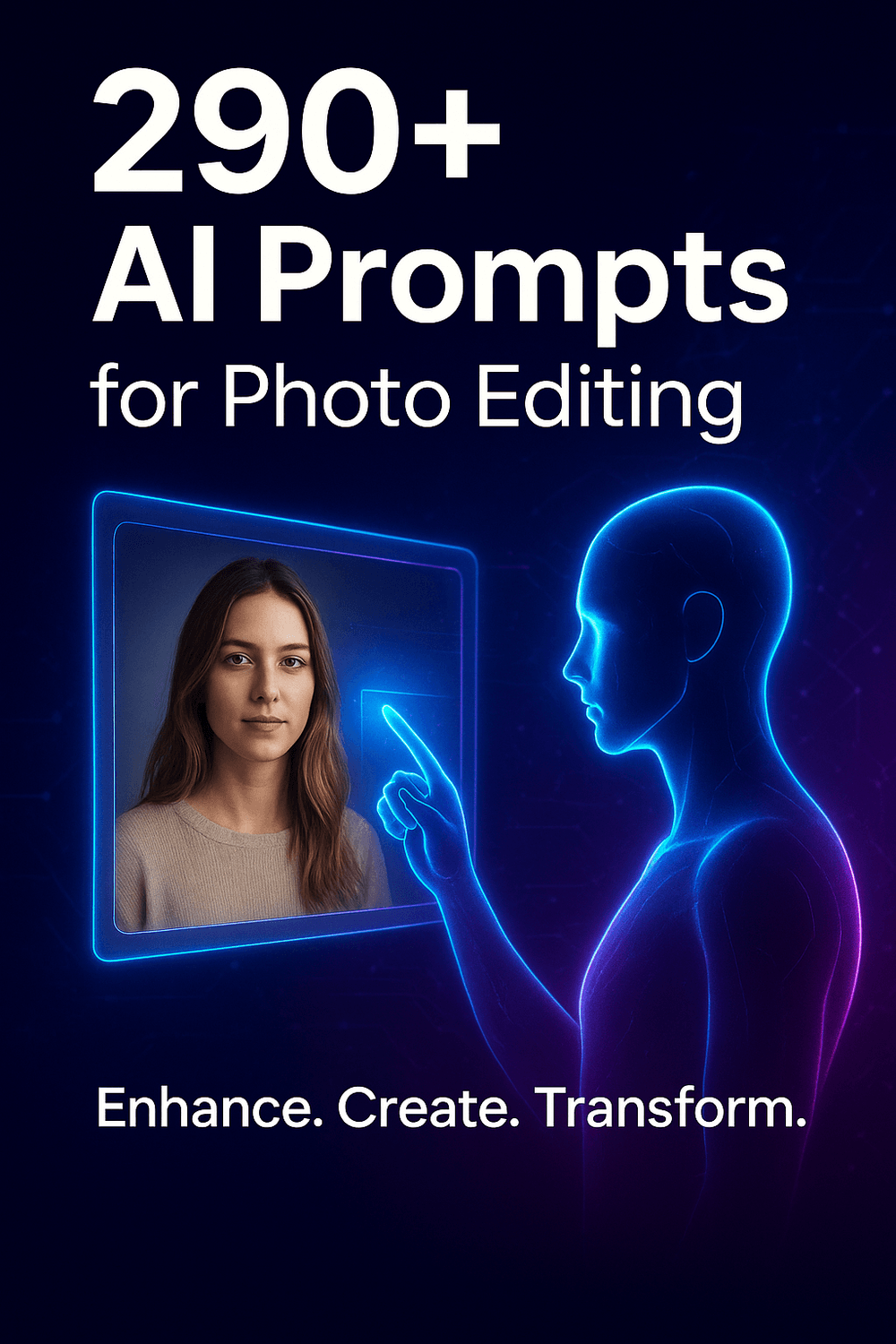I’ve always been fascinated by how far artificial intelligence has come. But one question kept bugging me:
“What can ChatGPT really do — beyond the usual writing and brainstorming stuff everyone talks about?”
So, I decided to put it to the test. I asked ChatGPT 100 different prompts, covering everything from business and marketing to mindset, productivity, and creativity. I wanted to see just how smart, helpful, and human-like it could get.
What I discovered blew my mind.
Some responses were brilliant. Some were weird. A few were completely unexpected. But every single one taught me something valuable about how to communicate with AI — and how to unlock its full potential.
This post is my honest breakdown of that experiment: the lessons I learned, the surprises I found, and why your prompts matter more than you think.
And by the way — if you’re serious about mastering ChatGPT, there’s a resource I wish I had before I started:
👉 The ChatGPT All-In-One Premium Pack — a massive library of 4,000+ prompts for every use case you can imagine. It’s like having a cheat code for AI.
Ready? Let’s dive in.
🧩 Why 100 Prompts? (The Experiment Setup)
When I decided to run this test, I wanted it to be more than just random questions thrown at an AI. I wanted a structured experiment — something that could reveal how powerful ChatGPT really is when used intentionally.
So, I broke the test into 10 major categories, each representing a different area of life or work. I pulled inspiration directly from the ChatGPT All-In-One Premium Pack, which organizes prompts in a way that feels like you’re unlocking hidden skill sets one by one.
Here’s how I structured it:
| Category | What I Tested | Goal |
|---|---|---|
| Career & Business | Resume rewrites, business ideas, startup advice | See if ChatGPT could act like a professional consultant |
| Content Creation & Copywriting | Blog outlines, ad copy, storytelling prompts | Measure creativity and brand tone |
| Personal Growth & Mindset | Motivation prompts, reflection prompts, journaling prompts | Test emotional intelligence and tone |
| Productivity & Time Management | Scheduling hacks, focus routines, time-block plans | Evaluate practical, actionable guidance |
| Finance & Investing | Budget tips, stock explanations, real estate insights | Check for accuracy and clarity |
| Problem Solving & Innovation | Complex "what would you do if..." scenarios | Observe logic and creativity |
| Relationships & Communication | Conflict resolution, empathy advice | Test emotional nuance |
| Creativity & Hobbies | Idea generation, art prompts, writing exercises | See how imaginative ChatGPT can be |
| Travel & Culture | Travel planning, cultural lessons, local tips | Test personalization and local insight |
| Marketing & SEO | Keyword strategy, content calendar creation, email sequences | Gauge real-world utility for professionals |
By keeping each section intentional, I could analyze how well ChatGPT adapted its tone, style, and reasoning depending on the type of prompt.
And to keep it fair, I used the same approach for each test:
Typed the prompt exactly as written — no extra context.
Took screenshots of each raw result.
Evaluated it for usefulness, accuracy, and creativity.
👉 You can do the same by using the pre-organized prompts from the ChatGPT All-In-One Premium Pack. It includes over 9000+ categorized prompts, so you can run your own mini AI experiments.
💡 Lesson #1: The Quality of Your Prompt Determines the Quality of Your Results
One of the biggest “aha!” moments from this experiment was this simple truth:
ChatGPT isn’t smart on its own — it mirrors your clarity.
If you ask vague questions like “Tell me how to be successful,” you’ll get generic motivational fluff. But if you refine your prompt, something magical happens.
🧪 Example Test #1
Prompt (Basic):
“How can I be more successful in life?”
ChatGPT’s response was simple:
Set clear goals
Stay consistent
Manage your time wisely
Good advice, sure — but nothing groundbreaking.
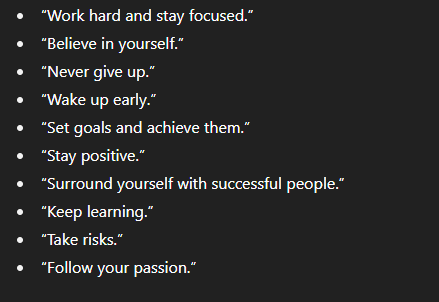
🧪 Example Test #2
Prompt (Upgraded Using Prompt Engineering):
“Act as a life coach. Give me a 7-day action plan to develop millionaire habits, including mindset, routines, and one practical exercise per day.”
This time, ChatGPT generated a detailed, actionable 7-day roadmap — complete with exercises, reflection ideas, and motivational triggers.
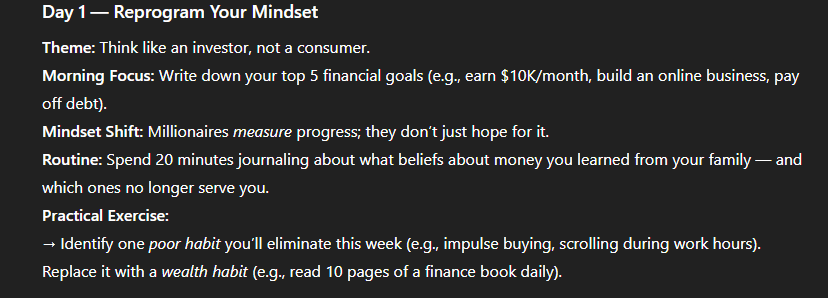
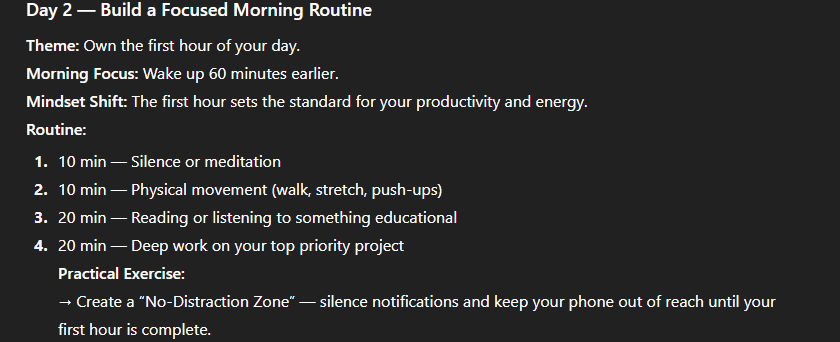
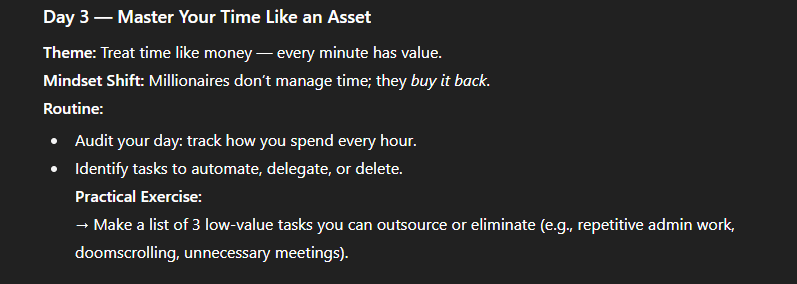
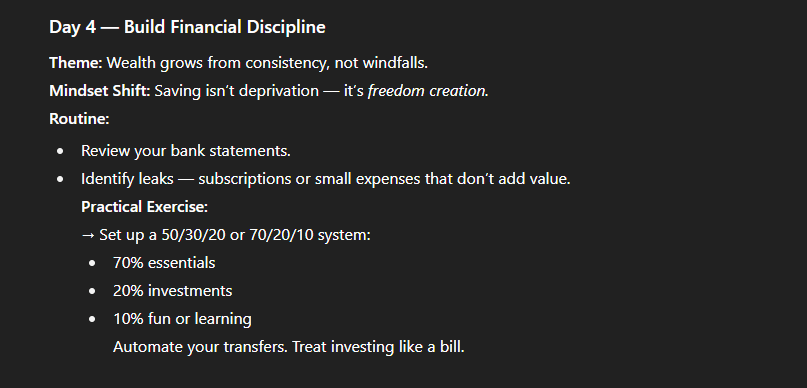
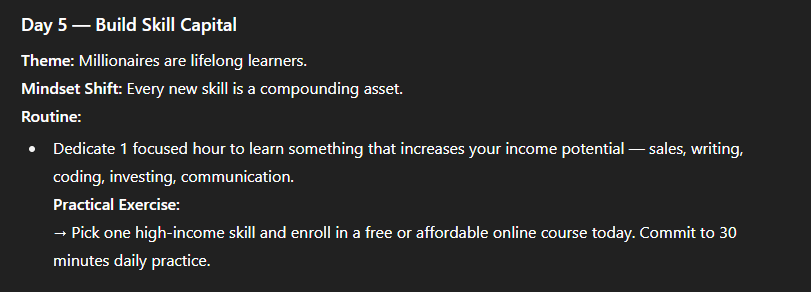
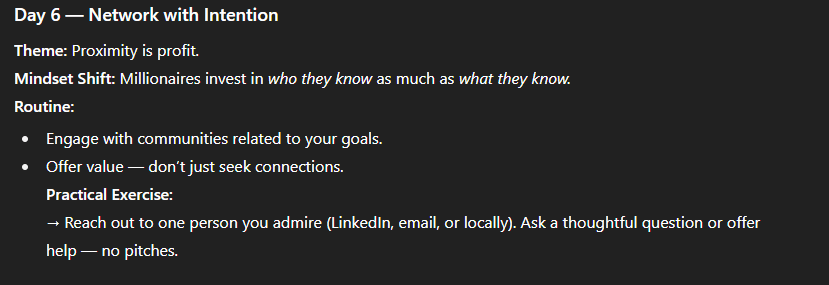
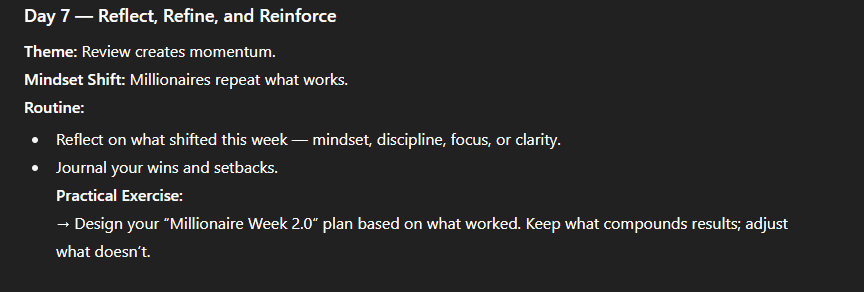
🎯 What I Learned
When you tell ChatGPT who to be, what you want, and how you want it,
It performs like a personal expert — not just an assistant.
💬 Pro Tip:
Inside the ChatGPT All-In-One Premium Pack, you’ll find:
✅ 150+ “Act As” prompts
✅ 9000+ categorized prompts
✅ 400+ plugins and guides
Each one is designed to help you get pro-level answers instantly — without trial and error.
⚙️ Lesson #2: ChatGPT Can Be a Productivity Multiplier (If You Treat It Like a Team Member)
Here’s something I didn’t expect to learn after 100 prompts:
ChatGPT isn’t just a tool — it’s a teammate.
When you start delegating tasks to it like you would to a real assistant, it starts behaving like one.
The key is in how you frame your prompts.
Instead of asking “How can I manage my time better?” try “Act as my productivity coach and help me design a realistic 5-day work schedule based on deep focus, rest, and creative energy flow.”
Let’s see that difference in action 👇
🧪 Example Test #1: Basic Productivity Prompt
Prompt:
“Give me tips to be more productive.”
ChatGPT’s response:
A short, generic list — eliminate distractions, prioritize tasks, take breaks.
Not wrong… but not actionable either.
🧪 Example Test #2: Role-Based Prompt (Team Member Approach)
Prompt:
“Act as my personal productivity coach. I work from home, have trouble staying focused, and often procrastinate. Create a 5-day realistic schedule to improve my focus and output — include time blocks, breaks, and daily motivation tips.”
ChatGPT’s response:
Boom 💥 — a fully organized 5-day schedule, including morning focus blocks, creative bursts, lunch breaks, evening wind-down tips, and even motivational reminders like:
“End each day by writing down three small wins.”
This is where ChatGPT starts feeling humanly helpful.
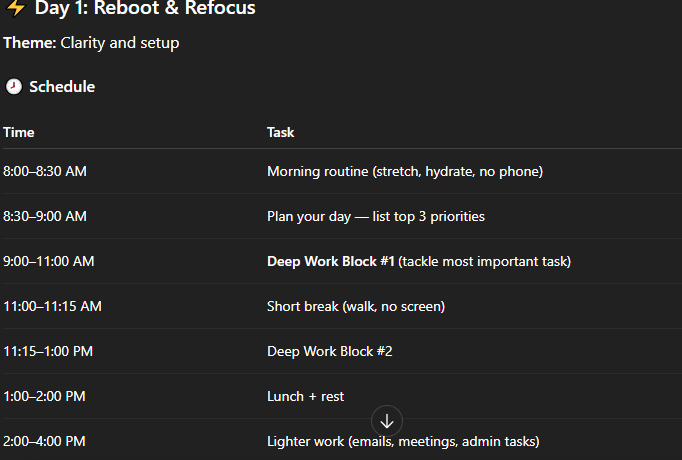
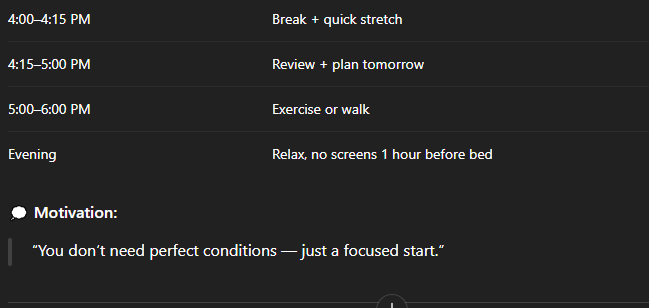
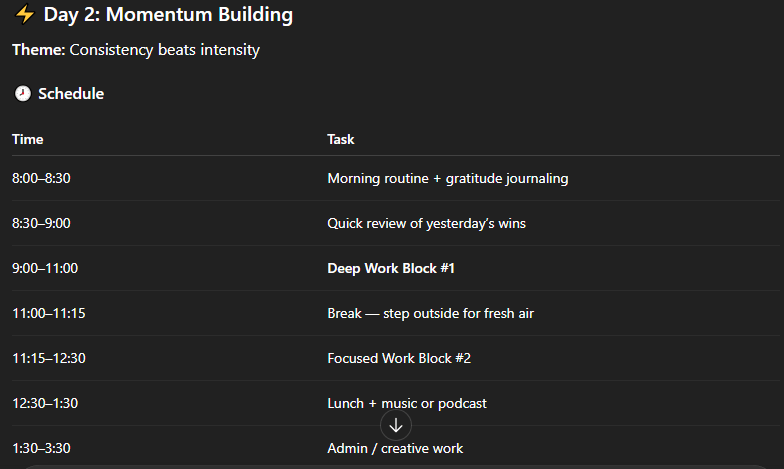
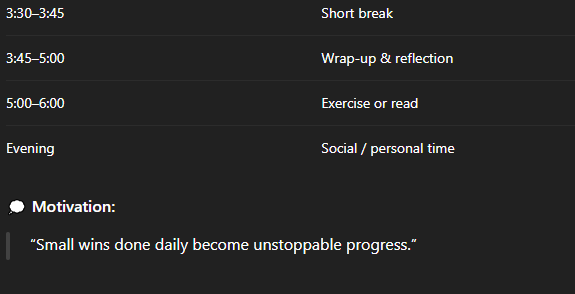
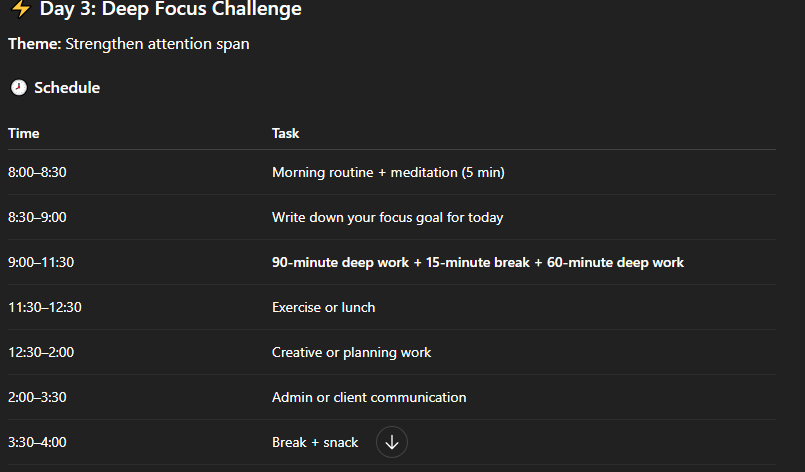

........ followed by
🧭 Realization
I realized ChatGPT could take over mental load — the constant thinking and organizing that drains your energy.
It’s not just giving answers; it’s structuring your day.
When I started treating ChatGPT like a junior team member, not a robot, my productivity doubled.
💬 Pro Tip:
The ChatGPT All-In-One Premium Pack includes Productivity & Time Management Prompts designed to:
Build optimized daily routines
Automate repetitive thinking tasks
Create balanced schedules based on your goals
These are the exact kind of prompts that help you work smarter, not harder.
🎨 Lesson #3: ChatGPT Can Think Creatively — If You Feed It Imagination
Before this test, I assumed ChatGPT was mostly “logical.” Great at facts and summaries, but not necessarily creative.
I was wrong.
After experimenting with over a dozen creative prompts, I discovered that ChatGPT can actually brainstorm, write, and imagine at a near-human level — if you feed it the right kind of inspiration.
💭 Lesson learned: ChatGPT mirrors your energy and curiosity. If you sound imaginative, it becomes imaginative.
Lorem ipsum dolor sit amet, consectetur adipisicing elit. Autem dolore, alias, numquam enim ab voluptate id quam harum ducimus cupiditate similique quisquam et deserunt, recusandae.
🧪 Example Test #1: Flat Prompt
Prompt:
“Write a story about a man who learns to fly.”
ChatGPT’s response:
A basic short story — predictable and safe. It read more like a children’s bedtime tale than something worth sharing.
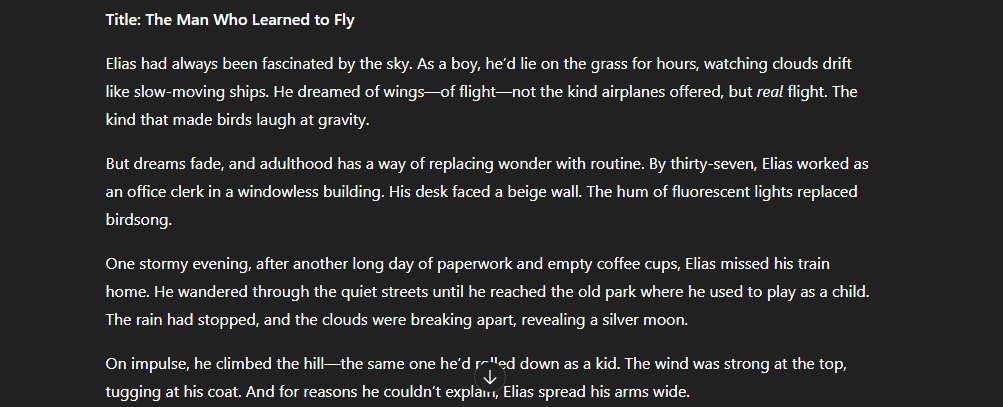
...............
🧪 Example Test #2: Enhanced Creative Prompt
Prompt:
“Act as a screenplay writer. Write the opening scene of a short film where a burned-out engineer discovers he can fly — but every time he does, he loses a memory. Make it emotional, cinematic, and end on a cliffhanger.”
ChatGPT’s response:
This time, the result was stunning — vivid descriptions, emotional dialogue, and a powerful hook. It even used film-like pacing and sensory language.
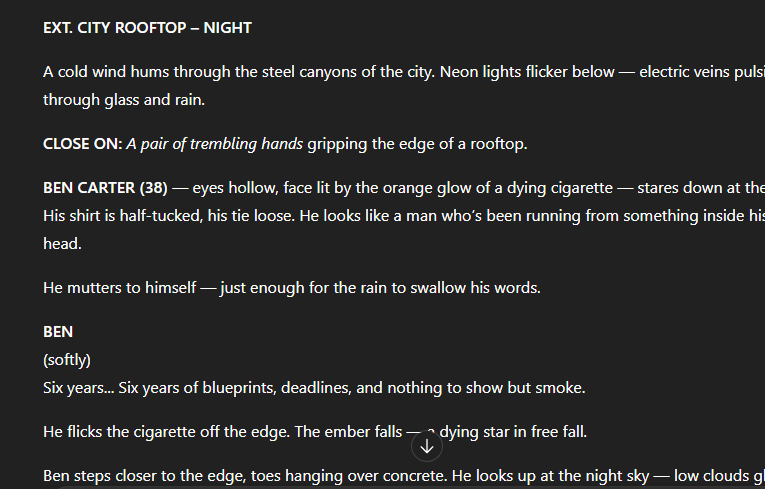
...............
🧠 What I Learned
Creativity doesn’t come from ChatGPT alone — it’s co-created.
When you inject emotion, context, and constraints, ChatGPT becomes a powerful creative partner.
This is especially useful if you’re:
A content creator looking for story hooks
A writer or filmmaker developing ideas
A marketer crafting emotional copy or ads
📊 Lesson #4: ChatGPT Can Handle Real-World Expertise (If You Frame It Like a Case Study)
By the time I reached prompt #60, I wanted to know how well ChatGPT could handle complex, real-world problems — things people usually pay consultants, marketers, or coaches to do.
So, I shifted from casual prompts to case-study-style questions, the kind that require step-by-step reasoning.
And that’s when ChatGPT really started showing its depth.
🧪 Example Test #1: Weak Prompt
Prompt:
“How can I make my business more successful?”
ChatGPT’s response:
Generic advice — define your audience, market your product, offer good service.
It wasn’t wrong, but it felt like a Google search summary.
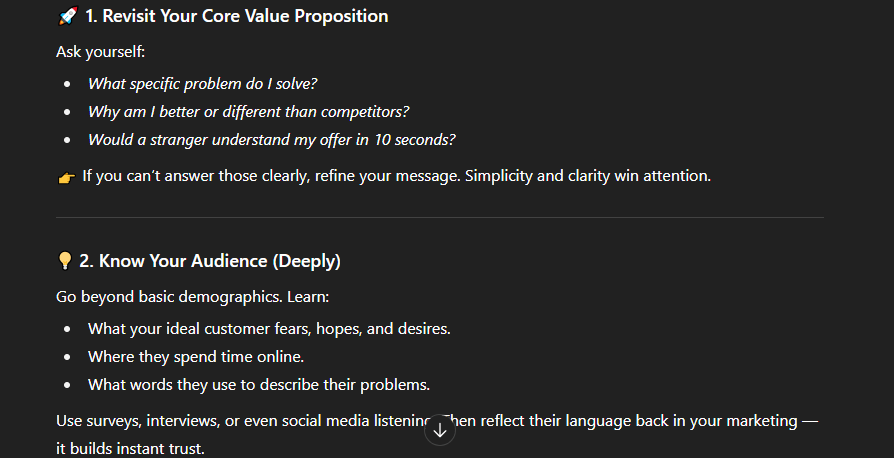
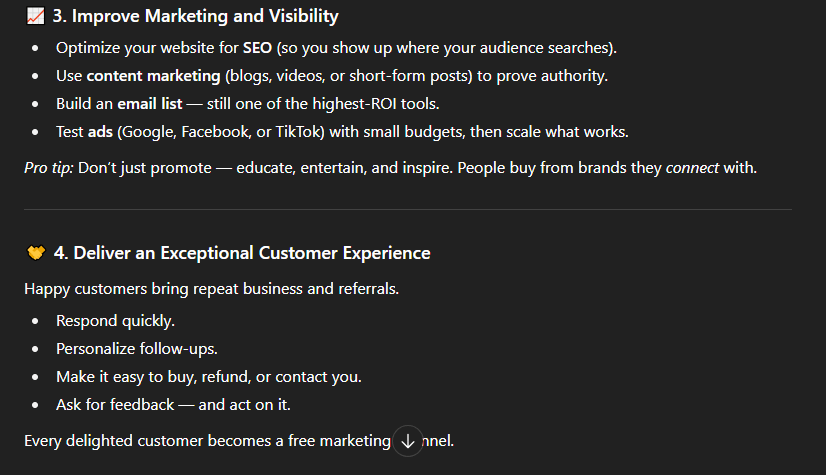
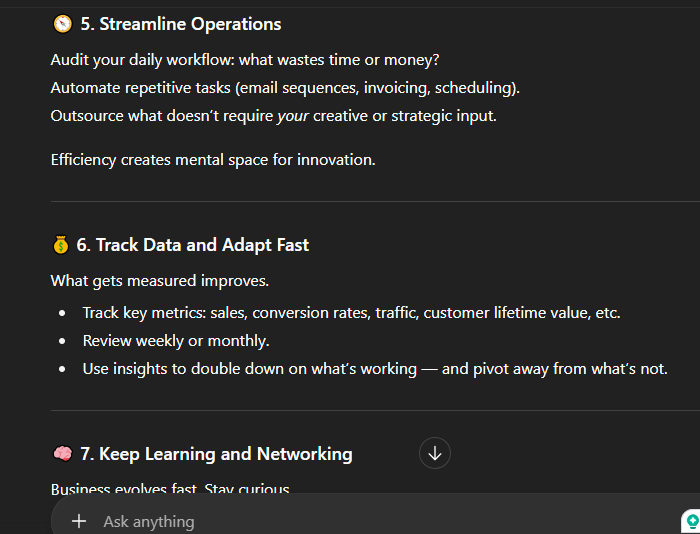
🧪 Example Test #2: Expert Case-Style Prompt
Prompt:
“Act as a business strategist. My e-commerce store sells handmade candles but sales have slowed. Analyze possible causes and suggest a 3-step action plan with short-term and long-term solutions.”
ChatGPT’s response:
Detailed and realistic.
It broke down possible issues (weak ad targeting, low repeat customers, seasonal drop), then gave a 3-step action plan:
Reoptimize ad copy for emotional storytelling.
Launch a loyalty email sequence.
Partner with micro-influencers to regain visibility.
It even included measurable KPIs( or Key Performance Indicators) — something I didn’t expect.
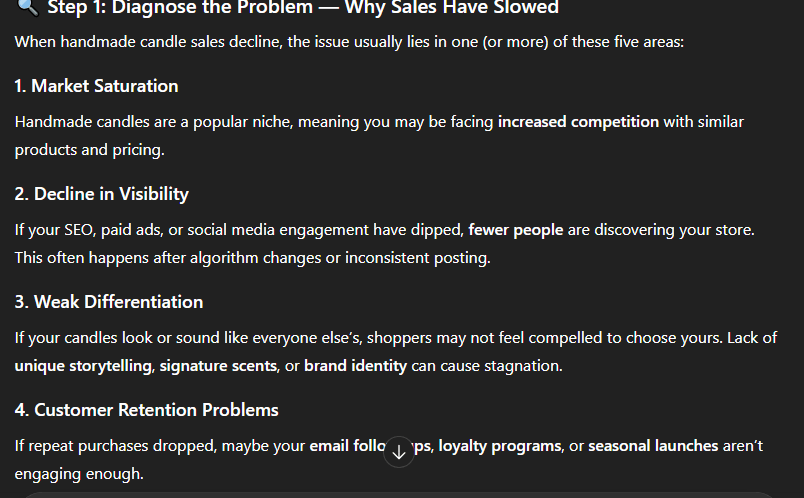
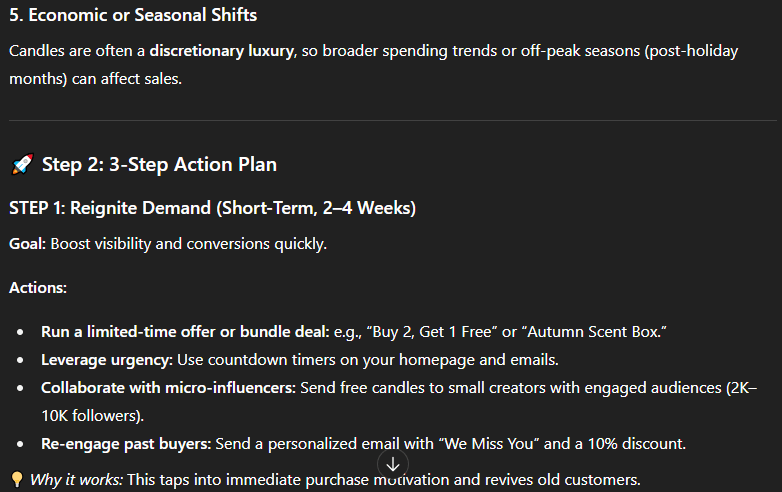
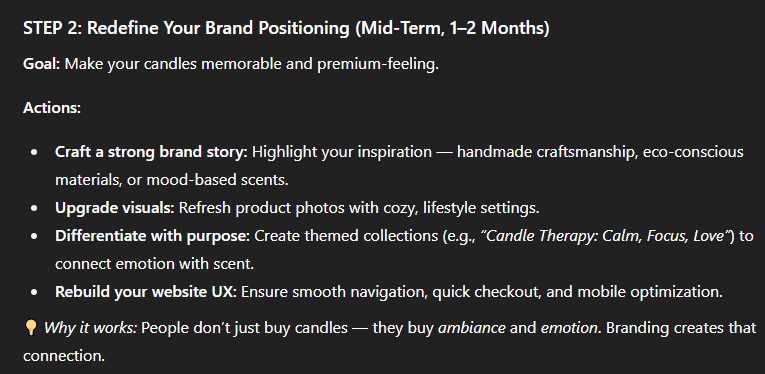
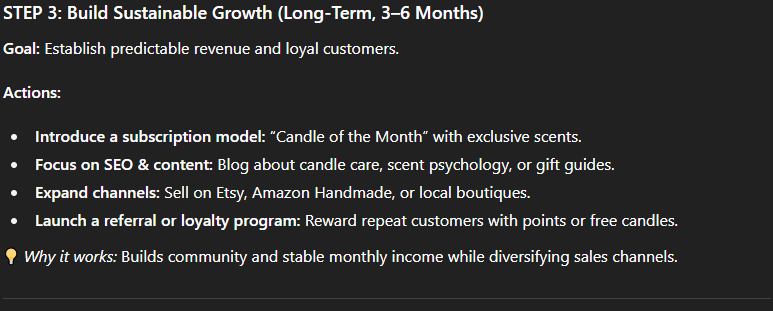
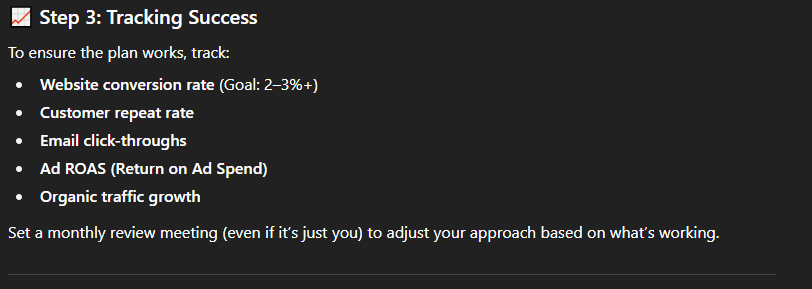
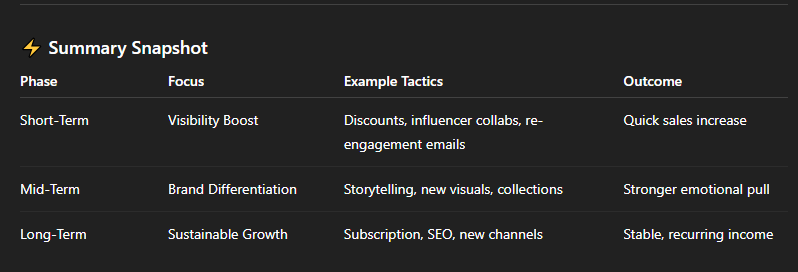
Compared to test one, you can see that test 2 is more detailed
💡 What I Learned
When you treat ChatGPT like an analyst, advisor, or consultant, it steps up.
The trick is to frame your prompt like a real-world scenario — provide background, specify your role, and ask for structured reasoning.
This works incredibly well for:
Business strategy
Marketing campaigns
Financial analysis
Real estate insights
Entrepreneurship planning
💡 Lesson #5: Your First Draft Isn’t the Final Answer (Iterate Like a Pro)
One of the biggest mistakes I made early on was accepting ChatGPT’s first answer as the final one.
But once I started iterating, the quality of my results skyrocketed.
Here’s the thing — ChatGPT gives you a version, not the version.
Just like any creative process, the gold often comes after refinement.
🧩 Real Example
Prompt 1:
“Write a YouTube script about building confidence.”
The response?
Pretty standard — motivational quotes, basic advice, nothing new.
Then I replied:
“Make it sound like an experienced psychologist explaining the science behind confidence, with relatable examples and a calm, educational tone.”
The result?
🔥 Instantly more engaging, credible, and practical.
Then I went one step further:
“Now make it conversational, as if it’s a TED Talk that keeps the audience hooked till the end.”
By the third version, I had something worthy of a viral video script.
🧠 Why This Matters
Iteration is where AI + human creativity truly blend.
You guide, refine, and redirect — just like a director guiding an actor to nail the perfect scene.
Each time you add feedback (e.g., “make it more data-driven,” “simplify the tone,” “add emotional appeal”), you’re training ChatGPT in real-time for your needs.
Try This Yourself
Pick any topic and run this mini workflow:
Ask ChatGPT to draft something simple.
Then say, “Let’s improve it. Make it more conversational and emotionally engaging.”
Finally, ask for “One last version that could go viral on social media.”
You’ll be amazed at how each iteration compounds in quality.
💡 Lesson #6: Great Prompts Are Built on Curiosity, Not Commands
If there’s one mindset shift that changed everything for me, it’s this:
👉 Stop commanding ChatGPT. Start collaborating with it.
When I stopped saying “Do this” and started asking “What if we tried this?”, the quality of my interactions exploded.
Example
When I said:
“Write a blog post about AI tools for entrepreneurs.”
The output was okay — a typical listicle with no real depth.
But when I asked:
“If you were an entrepreneur in 2025 trying to scale a one-person business using AI tools, what would your top priorities be — and why?”
Suddenly, the response sounded like advice from a real business strategist.
It had nuance, reasoning, and structure — not just information.
Why This Works
ChatGPT responds differently when your prompt shows curiosity instead of control.
Commands make it deliver predictable answers.
Questions make it think, analyze, and create context — the same things human experts do naturally.
In other words:
Commands = completion.
Curiosity = collaboration.
And collaboration always produces better results.
Try This Yourself
Here’s a challenge you can use in your own tests:
❓ Instead of: “List the best habits for success.”
💬 Try: “What are some habits that most successful entrepreneurs practice daily — but rarely talk about?”
Notice how the second one unlocks hidden insights and original phrasing, because you’re inviting ChatGPT to reason, not regurgitate.
💡 Lesson #7: The “Act As” Framework Is a Game-Changer (and Why Everyone Should Use It)
If I had to pick one feature that turned ChatGPT from a “smart chatbot” into a personal powerhouse, it would be this:
👉 the “Act As” prompt format.
This simple trick changes how ChatGPT thinks, speaks, and solves problems. Instead of answering like a generalist, it performs like a domain expert — tailored to your needs.
Real Example
Instead of asking:
“Help me write a business plan.”
Try this:
“Act as a seasoned startup consultant who has helped 100+ entrepreneurs build successful SaaS businesses. Help me create a step-by-step business plan for my AI tool startup targeting digital creators.”
The difference is night and day.
ChatGPT suddenly provides:
Professional language
Deeper reasoning
Actionable structure (with metrics, costs, and realistic steps)
It’s not just writing anymore — it’s strategizing.
Why It Works
The “Act As” framework taps into contextual simulation — when ChatGPT roleplays an identity, it filters its entire reasoning through that perspective.
This unlocks:
Tone accuracy: your prompts sound like advice from experts, not robots.
Domain insight: better technical or professional responses.
Empathy: improved conversational quality when dealing with personal or sensitive topics.
Essentially, you’re loading a mindset into ChatGPT before the actual task.
⚙️ Try These “Act As” Prompts Yourself
Here are a few from the ChatGPT All-In-One Premium Pack (use these when testing):
💼 Act as a LinkedIn Growth Coach — “Review my profile and tell me exactly how to increase engagement by 50%.”
✍️ Act as a Copywriting Mentor — “Critique this ad and suggest stronger emotional triggers.”
🧠 Act as a Mindset Coach — “Help me overcome creative burnout in 3 steps.”
📊 Act as a Data Analyst — “Explain my Excel sheet like I’m five — and tell me what insights it hides.”
Each of these produces human-like, niche-level responses that sound like a paid expert — not a chatbot.
🎯 Quick Takeaway
If you remember just one thing from this section, let it be this:
“Your results depend on who ChatGPT thinks it is when it answers.”
Once you start telling ChatGPT who to “act as,” you stop getting generic text and start getting expert-grade outcomes.
⚡ Lesson #8: Combining AI Tools + Prompts = 10x Productivity
By the time I reached prompt #80, I realized something powerful:
Prompts alone are great, but combine them with AI tools and plugins, and you unlock exponential results.
The ChatGPT All-In-One Premium Pack doesn’t just give you prompts — it gives you AI tools, plugins, and practical guides so you can take output and turn it into real-world action.
Example
Instead of just asking ChatGPT:
“Generate a weekly content calendar for my blog.”
I used the AI tools + prompt combo approach:
Asked ChatGPT to generate the content ideas.
Used an AI scheduling plugin to assign dates and optimize posting times.
Integrated another plugin to check SEO keywords for each article.
Result? ✅ A fully optimized, ready-to-publish content plan in less than 15 minutes — something that would normally take hours of research and planning.
Why This Works
Combining prompts with plugins and AI tools allows you to:
Automate repetitive tasks — like content scheduling or email drafts.
Enhance accuracy — like SEO analysis or data validation.
Save massive time — because ChatGPT + tools handle the heavy lifting.
It’s like having a personal assistant, strategist, and analyst all in one.
📋 Try This Yourself
Pick a task you normally dread, like:
Email campaigns
Social media planning
Data analysis
Budget planning
Then:
Generate ideas or draft with ChatGPT.
Feed it into a plugin or AI tool from the pack.
Compare time spent vs. your traditional workflow.
You’ll see exactly why combining prompts + tools is a productivity multiplier.
📚 Lesson #9: ChatGPT Can Personalize Learning and Growth
One of the most surprising discoveries from testing 100 prompts was how effectively ChatGPT can customize learning.
Whether you want to master a new skill, improve your writing, or boost your professional expertise, ChatGPT can adapt to your personal pace, style, and goals.
💡 Key insight: AI is most powerful when it’s not just answering questions, but guiding your growth journey.
Example
Prompt (Generic):
“Teach me SEO.”
Response: A broad explanation of SEO basics — general but not actionable.
Prompt (Personalized):
“Act as an SEO coach for a beginner content creator. Create a 4-week learning plan with daily exercises, resources, and practical tasks to improve my on-page SEO and keyword research skills.”
Result:
A detailed, step-by-step roadmap
Daily actionable tasks and exercises
Clear progression that scales from beginner to intermediate
Why This Works
ChatGPT can mimic a private tutor or mentor when:
You define your role (student, beginner, professional).
You specify your goal (skill mastery, project completion, knowledge acquisition).
You request structured guidance (daily/weekly plan, exercises, or checkpoints).
This approach transforms ChatGPT from a question-answering bot into a personal growth assistant.
Try This Yourself
Pick a skill or topic you want to improve and run this workflow:
Ask ChatGPT for a basic overview.
Refine your prompt with role + goal + timeline.
Iterate for more details, examples, or exercises.
You’ll have a personalized, actionable learning plan in minutes — something that normally takes hours of research.
⚠️ Lesson #10: ChatGPT Isn’t Perfect — But Knowing Its Limits Makes You Unstoppable
After testing 100 prompts, one truth became crystal clear:
ChatGPT is powerful — but it’s not infallible.
No matter how good your prompt is, AI can still make mistakes, omit context, or overgeneralize.
The key is knowing its limitations and using it strategically.
🧩 Real Example
Even after crafting a detailed prompt like:
“Act as a financial advisor and provide a 3-step investment plan for a beginner in stocks and crypto.”
ChatGPT generated:
Solid beginner-level tips ✅
But occasionally suggested overly generic strategies or skipped critical risk considerations ⚠️
If I had blindly followed the first draft, I could have missed key insights or made poor decisions.
Why This Matters
AI works best when:
You verify the information (especially finance, health, or legal topics).
You test outputs — like you’re doing with screenshots for this blog post.
You iterate and refine, combining human judgment with AI speed.
Think of ChatGPT as:
A brilliant assistant who still needs a knowledgeable supervisor — and that supervisor is you.
📋 Takeaway
The goal isn’t perfection — it’s smart collaboration:
Ask the right questions
Test outputs
Iterate with your knowledge
This approach turns ChatGPT into a supercharged partner while keeping you in control.
🔑 Lesson #11: The 100-Prompt Experiment Changed How I Use ChatGPT Forever
After testing 100 different prompts across creativity, productivity, business, personal growth, and learning, one thing became undeniably clear:
ChatGPT isn’t just a tool — it’s a versatile personal and professional accelerator.
Here’s how my workflow evolved:
1️⃣ From Passive Tool to Active Partner
Before the experiment, I treated ChatGPT like a “magic text generator.”
Now, I treat it like a team member, mentor, and creative partner — someone who can help me brainstorm, analyze, and structure ideas.
2️⃣ Prompts Are the Real Power
I learned that:
The quality, specificity, and framing of a prompt determines the quality of the output.
“Act As” prompts and role-based prompts unlock expert-level responses.
Iteration and curiosity turn generic outputs into actionable insights.
3️⃣ AI + Tools = Exponential Results
Combining ChatGPT with AI plugins and productivity tools transformed simple tasks into time-saving systems. Examples:
Content calendars fully optimized with AI scheduling plugins
Personalized learning plans for skill-building in days instead of weeks
Strategic business plans simulated by ChatGPT acting as a consultant
4️⃣ Human Oversight Remains Key
Even the best prompts aren’t foolproof. I learned to test, verify, and refine every output.
This approach ensures accuracy and lets you harness AI safely and effectively.
Final Takeaways
Treat ChatGPT like a collaborator, not just a tool.
Quality prompts + iteration = high-value outputs.
Combine with AI tools for productivity and automation.
Verify outputs and maintain human oversight.
After 100 prompts, I don’t just use ChatGPT to answer questions — I use it to think faster, create smarter, and work more efficiently.
LATEST BLOG POSTS
© businesshub360.systeme.io
All rights reserved


